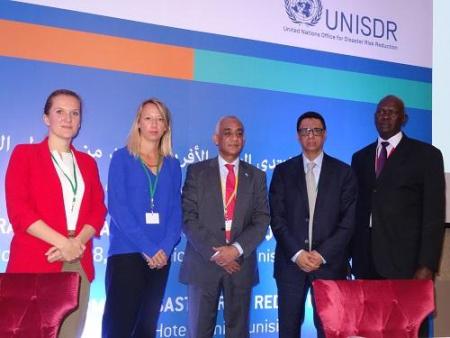
(from left) Panellists Nina Stuurman, IOM; Katie Peters, ODI; Hamza Said Hamza, Somalia; Abdessalam Ould Ahmed, FAO; Banak Wal, South Sudan
By Denis McClean
TUNIS, 12 October, 2018 - The increasing overlap between disaster and conflict situations came under scrutiny today at a lively special session of the Africa-Arab States Platform on Disaster Risk Reduction.
The current threat of a cyclone off the coast of Yemen, home to the world’s worst humanitarian emergency, was cited during the Special Session on DRR in a Fragile and Conflict Context.
South Sudan's Director-General of Disaster Management, Banak Wal, recalled how the response effort for 150,000 flood-affected people in 2013 was derailed by the eruption of renewed conflict in the capital Juba which donors quickly turned their attention to.
Mr Wal said it was impossible to get grassroots support for disaster risk reduction policies when they were in dire need of action to meet their needs as a result of conflict. “You cannot talk today about development when there is no access to many parts of the country.”
In his view, it was unfortunate that UN member states adopting the Sendai Framework for Disaster Risk Reduction decided not to include conflict.
ODI research fellow, Katie Peters, cited the 2008 floods in Yemen, drought in Nigeria, as examples of disasters affecting conflict areas.
“Disaster risk reduction in conflict should be a priority. I would argue that disasters are neither natural nor conflict neutral,” she said.
Ms. Peters said there was “a moral imperative” to provide disaster risk reduction in conflict areas and it was not a marginal concern given the prevalence of conflict across Africa and the Arab States.